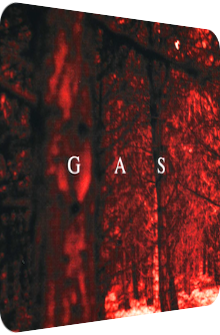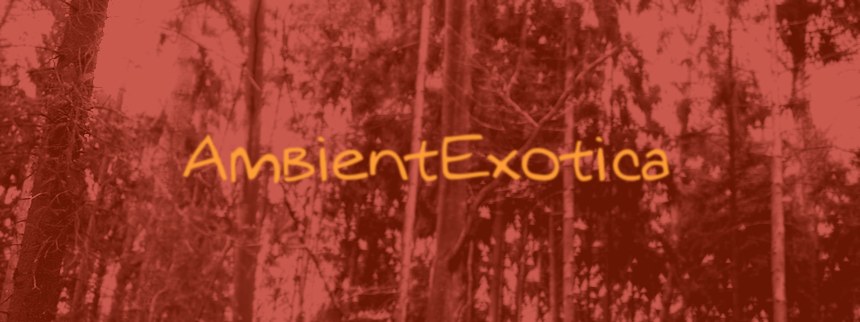
Gas
Zauberberg
1997
With the follow-up of his successful self-titled Gas album of 1996, Wolfgang Voigt definitely found his voice and style, merging modulated samples of classical music with electronic Ambient layers and intimidating soundscapes. Zauberberg is the album I'm talking about, which is the second of four consecutive Gas releases that are all compiled on the album Nah Und Fern. One of the two big changes in comparison to the debut consists of the iconic artwork: the letters GAS are written on top of an eerie, dusky red front cover that is a fitting foil to the music and a good pointer of the things to come, which leads to the second change, namely the focus on darkness and majesty. While Gas has been a very deep and yet bright album, the seven unnamed tracks of Zauberberg are cavernous, gloomy and deep. The majority of them is beat-driven, having more similarity to Deep House or Tech House tracks than to Ambient music, but the loops themselves remain in the latter genre. This is considered Voigt's most coherent album, and I am willed to agree without much ado. The oxymoronic contradiction of a dangerous shelter has never before been so perfectly depicted in Ambient music.
Zauberberg 1 is anything but beautiful and utterly majestic. The darkness hasn't arrived yet, and the track can be understood as a transition device that accompanies the listener from the last track of Gas to Zauberberg . Silky clicks and pops are merged with enormously ecclesial and festive three-note drone loops. I am sure that Voigt uses a real church organ as the base for this song, which is then bolstered by additional synth washes that merge perfectly with the organ. This song reminds me of the intimate, reflective nature of Christmas. It is the friendliest, warmest song of the album and one of two beatless compositions. The drones get deeper and the organ thinner near the end, exemplifying the growing distance between this place of glowing heat and the things that are to come. The 14 minute long Zauberberg 2 fades in quickly, already jam-packed with muffled beats and various dark synth and violin strings. The atmosphere isn't terrifying (yet), but a certain feeling of uneasiness cannot be denied. The pops and crackles are once more ubiquitous devices, but they are hardly noticeable, for the deepness of the strings is remarkable. The song doesn't change much, but in the second half, glistening xylophone-like bells are added and the strings are pitched into higher regions. The last 90 seconds are beatless, unveiling the full scope of the string melange. Zauberberg 3 is heavier on the synth side and quite a bit brighter, but the brightness isn't joyful but eschatological and danger-evoking. The steady 4/4 beats and the scattered clicks build deceptive walls that can distract the listener from the background layers; but one you listen carefully, you hear deep drones that are certainly dark, but are an oasis of tranquility in the center of the ethereal synths, at least to me. While Zauberberg 2 was rather subtle in its presentation of darkness, the third track is glaringly pompous in its presentation of a vespertine final point – but it is also deep and sophisticated enough to capture the listener in its multiple layers.
Zauberberg 4 adds a new style to the album. A warped entanglement of altered acoustic guitars and a trombone melody is presented, as usual under the guidance of pumping beats which get deeper and more dubby during the first 30 seconds of this rather short song. A permanently frizzling drone can be heard, similar to a hot pan or distant rain. This fuzzy filter cannot distract from the crystalline guitar layers. The whole atmosphere seems to be damp and spectral, like a mysterious fairy tale in a dark forest – although this mood is reserved for Gas' next album, Königsforst (King's Forest) of 1998, the front artwork of Zauberberg backs up such an interpretation as well. Zauberberg 5 reaches a climax in eeriness. It starts as usual with straight beats, but there is no synth, no melody, just a barely audible blurred synth string in the background that grows larger over time, then unveiling its multiple facets, for it encapsulates multiple frightening layers – the suspense level grows even higher when darker synth strings pulsate and the now iconic eschatological synth swirls of Zauberberg 3 appear again. Their towering impact is all the more scary in the darkest tune of the album. Despite its beats, I can wholeheartedly recommend this track to Dark Ambient fans. Supremely gruesome! The monotonous drones of Zauberberg 6 aren't much easier on the mind. Rhythmical synth howls traverse regularly, similar to short storm bursts. A filtered synth string is added, and tweaked clarinet sounds are enhancing the cavernous setting from the deepest alcoves of the track. In the middle of the track, one last scary layer is added: piercing, high-pitched horror movie strings tremble along, and nothing else changes apart from the last 50 seconds when the beats wane all of a sudden and the tack fades out and makes room for the final Zauberberg 7 , the second beatless and thus pure Ambient track. It immediately picks up where Zauberberg 1 stopped. The setting is the same, the synth and instrument setup is known as well, but the melody is more melancholic and has to go through several filters, thus becoming hazy at times or intimidatingly droning. But there is also a sort of enlightenment and hapiness perceptible, for the terrifying journey to the Zauberberg has come to an end – that's one possible interpretation. Since this is a coherent concept album, you can either swallow this idea or keep things simpler by realizing that it's just a great album closer and a majestic track overall.
Wolfgang Voigt delivers a modern masterpiece with Zauberberg , that only a few years later has been recognized by the music press as a remarkable album that intertwines elements and remnants of classical music with electronic surroundings. All the more important are the steady beats on the majority of the tracks, because they were for a long time considered as typical ingredients of dangerous techno music that suggests the use of drugs in order to fully enjoy it – this is 1998, after all. Voigt created his own microcosm under the Gas moniker, and with Zauberberg , he finally found his voice and specific sound. Each listener has a favorite among the 4 albums. I have as well. It is not Zauberberg. But I admire in awe the sophisticated setup of the multilayered textures, the blood-curdling mood it evokes and the gargantuan beats which always imply the idea of movement, of actively facing something or running away from it. The first and last Zauberberg tracks don't seem to fit, but they build one entity that is separated by the five beat-driven tracks. Whatever this separation means – it could mean anything at all –, these two are the obvious picks for Ambient fans. Voigt anticipates the Pop Ambient sound with these two tracks. Their festive style and the church-like strings are soothing, embracing entities. The majestic mood on track 1 and the melancholy on track 7 are singular peculiarities. The vast majority of Zauberberg is tense, nerve-recking and gloomy. It's a wild ride, and though the ambience takes primarily place in the background and in the sphere of the synth layers are interwoven real instruments, I consider this a powerful Ambient album nonetheless. Wholeheartedly recommended and easily available on the Nah Und Fern anthology that unites the four works of Gas.
Ambient Review 060: Gas – Zauberberg (1997). Originally published on May 18, 2012 at AmbientExotica.com.
